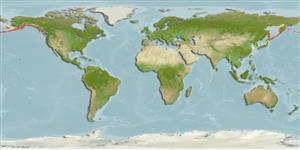Environment: milieu / climate zone / depth range / distribution range
Écologie
marin démersal; profondeur 0 - 80 m (Ref. 58017). Temperate
North Pacific: Japan to the Gulf of Alaska.
Taille / Poids / Âge
Maturity: Lm ? range ? - ? cm
Max length : 21.0 cm TL mâle / non sexé; (Ref. 2850)
Description synthétique
Clés d'identification | Morphologie | Morphométrie
Épines dorsales (Total) : 2; Rayons mous dorsaux (Total) : 41 - 45; Épines anales: 1 - 2; Rayons mous anaux: 29 - 34. Pelvic fin thoracic, consisting of 1 spine and 5 soft rays, not covered with scales. Length of scaled portion of caudal fin less than 1/2 its whole length. Maxillary extending to below about middle of eye. Attains about 20 cm SL.
Inhabits tide pools and shallow inshore areas (Ref. 2850).
Life cycle and mating behavior
Maturities | Reproduction | Spawnings | Egg(s) | Fecundities | Larves
Eschmeyer, W.N., E.S. Herald and H. Hammann, 1983. A field guide to Pacific coast fishes of North America. Boston (MA, USA): Houghton Mifflin Company. xii+336 p. (Ref. 2850)
Statut dans la liste rouge de l'IUCN (Ref. 130435)
Menace pour l'homme
Harmless
Utilisations par l'homme
Outils
Articles particuliers
Télécharger en XML
Sources Internet
Estimates based on models
Preferred temperature (Ref.
123201): 1.9 - 7.9, mean 3.6 °C (based on 316 cells).
Phylogenetic diversity index (Ref.
82804): PD
50 = 0.5703 [Uniqueness, from 0.5 = low to 2.0 = high].
Bayesian length-weight: a=0.00389 (0.00180 - 0.00842), b=3.12 (2.94 - 3.30), in cm total length, based on all LWR estimates for this body shape (Ref.
93245).
Niveau trophique (Ref.
69278): 3.6 ±0.3 se; based on size and trophs of closest relatives
Résilience (Ref.
120179): Haut, temps minimum de doublement de population inférieur à 15 mois (Preliminary K or Fecundity.).
Fishing Vulnerability (Ref.
59153): Low vulnerability (11 of 100).
